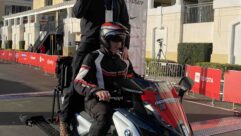THE DTV HOLY GRAIL good indoor 8vsb reception
Dec 1, 2000 12:00 PM,
Peter H. Putman
In the July and August issues of S&VC, I wrote about my tests of off-the-shelf antennas for terrestrial reception of DTV signals. These tests were conducted mainly to find a design that would help overcome the multipath problems that often make DTV signals drop out or disappear altogether – the dreaded “cliff effect.”
After testing nearly two dozen designs from Channel Master, Radio Shack and Terk Technologies, I decided to take out the hacksaw, screwdriver, electric drill, soldering iron and a pair of pliers and build a couple of UHF antennas that would provide reliable 8-level Vestigial Sideband (8VSB) reception. Why UHF? The majority of DTV stations currently broadcasting are using UHF channels, and many of those stations will remain on channels 16-51 once the transition to 100% DTV broadcasting is complete.
Thanks to Eric Hodges of Tektronix Corporation, I had an Advantest model 3661 RF spectrum analyzer, a device that lets you “see” chunks of the radio and TV spectrum. As I stated in my July column, a spectrum analyzer is essential to determine if a given DTV station’s 8VSB carrier wave is both strong enough to receive (typically about 15 dB carrier-to-noise ratio) and “level” across the carrier, with the effects of multipath minimized.
One of the biggest knocks on the current ATSC 8VSB system is that it’s difficult to achieve reliable indoor reception. Both NBC and ABC submitted a petition to the FCC in June that in essence claimed 8VSB was unreliable and not a good choice for a DTV transmission standard.
As I conducted my home-brew antenna run-through, further tests were done by a consortium of manufacturers, broadcasters and testing organizations in the Washington, D.C., area in late August and early September to determine the reliability of both the ATSC 8VSB standard and the competing COFDM standard used by many European, South American and Asian broadcasters. (The results are still pending.)
For my tests I set two goals: One was to build a small antenna that would be largely idiot-proof and would work reasonably well indoors or outdoors. The other was to construct a smaller version of the Channel Master 4221/3021 4-bay UHF screen antenna that had a little more gain but a lower profile.
“FRANKANTENNA”If you look through a typical antenna catalog – such as Radio Shack’s or Channel Master’s – you’ll see all the parts I used on different models: multi-element yagis…parabolic reflectors… even folded dipoles. I just worked like a chef – or a mad scientist – taking a little from here, a little from there, and blending it all together.
After several hours (and lots of wire bending, cutting, drilling and soldering) I had my two prototypes. They are ugly, to be sure, having been constructed from PVC pipe, #6 electrical ground wire, decorative radiator screens and brass rods. Figure 1 shows the smaller of the two antennas, a 3-element model with a full-wavelength folded dipole active element, a square reflector screen and a single director.
Figure 2 shows the adapted “X” driven element from the 3021 4-bay antenna, backed up by a square reflector screen and four directors. Most of the parts are held in place with silicon seal, while each side of the X element was soldered to a small lug at the bend, and a screw was driven through the lug into the PVC pipe for mounting. Additional silicon glue finished up the job.
Both antennas are fed to 75-ohm coaxial cable through a standard 300-ohm-to-75-ohm balun, although there might be a small standing wave mismatch. Most of the time, I saw fairly level 8VSB waveforms in areas of low multipath, so the effects of any SWR mismatches appear to be minimal.
LAB TESTSHow did they work? Pretty darn good. Figure 1 shows the small UHF antenna sitting on a tripod in my living room, pulling in signals from WFMZ-46 and WLVT-62 in Allentown, Pa.; over 24 miles distant. Neither station runs much power, and the antenna is shooting across 15 feet of floor, out thermopane windows (metallic glass) and through a 12-foot-high hedge and my neighbor’s house. Figure 3 shows just how weak the signal was from channel 62, yet it was sure and steady.
When I put the X-beam in my office – an even worse location for DTV reception – yet it reliably pulled in four of the five Philadelphia DTV stations, even with some really ugly 8VSB waveforms. Figure 4 shows a waveform for KYW-26 with quite a few loops and dips, while Figure 5 shows a rather bumpy waveform for WPVI-64. Note that in both cases, the pilot signal (that spike at the extreme left of the carrier) is of sufficient amplitude for the DTV receiver to detect and hold the signal.
I should add that in both my home and office tests a Terk model PDMA preamplifier was used to boost C/N levels, to make life a little easier for the Panasonic DTV tuners. This preamp doesn’t solve any multipath problems. It just raises the overall signal level so that the DTV tuner has more headroom in case of signal fading or severe multipath.
THE ACID TESTNow it was time to run the gauntlet. Several Internet forums and Web pages that cover DTV standards have made reference to a New York City “black hole” of DTV reception located in the apartment of nationally-known industry trade writer Mark Schubin. Mark’s bedroom has seen many a manufacturer and researcher set up antennas, receivers and spectrum analyzers in an attempt to get reliable reception of WCBS-56 and WNYW-44.
Mark’s location – about 40 blocks north of the Empire State Building, with windows exposed on the wrong side of the building – has proven such a formidable obstacle for indoor 8VSB reception that I decided to take my two “plumber’s special” antennas up there and see if perhaps they could defeat the multipath beast.
The outcome? Surprising success, but not in a way anyone expected. After aiming the antennas at the window and looking at some pretty horrible spectrum analyzer shots, I placed the small beam on the floor for a moment to move my tripod. Presto! WNYW-DT came in solid, with no drop-out. The same results were had with the X-beam. Swinging the antennas 90 degrees resulted in reception of WCBS-DT on the X-beam, although not quite as reliably.
Figure 6 shows the small yagi sitting on the floor, while Figure 7 shows Mark enjoying some afternoon cartoons on the Fox network while the antenna rests nearby. Figures 8 and 9 show the spectrum analyzer plots for WNYW-44 and WCBS-56, respectively, and they’re pretty ugly. Yet, Mark’s RCA DTC-100 DTV tuner was able to make sense of it all, multipath or not. (The Channel Master 7775 preamp was used again to boost overall signal levels.)
The day after I visited, Jim Kutzner of the Advanced Television Technology Center (ATTC) came to map the RF spectrum from Mark’s apartment. At one point, he placed a small Radio Shack corner reflector in the same spot as my antennas had been – on the floor – and was also able to receive WNYW-44 and WCBS-56, although not as dependably.
AFTERMATHRecently, I had the opportunity to take both antennas to a large home theater chain store in King of Prussia, Pa. During a manufacturer’s HDTV promo event, we disconnected the outdoor 8VSB feed from the local Philadelphia DTV stations and tried both antennas on a tripod support, right on the main floor. Again, successful reception of all five DTV signals was possible (with or without the preamp, depending on signal strength). KYW-DT’s signal was so strong that it locked up with a piece of co-ax connected to the preamp!
In short, it is possible to receive 8VSB signals indoors with multipath (or outdoors with multipath, for that matter). It takes a 3-way effort between the antenna, the DTV receiver’s equalizer and the DTV receiver’s 8VSB demodulator. All of these pieces of the puzzle have to be improved, and they will with time.
As I am writing this, an even smaller version of the “small” antenna is sitting on a short mast in my office, pulling in DTV stations from Allentown and Philadelphia. It measures only 12 inches in length, uses three elements and is also made from hardware store parts. An outboard Channel Master 7775 preamp is in line to boost overall C/N levels.
Your best bet to determine if a client can receive terrestrial 8VSB signals is to get your hands on a spectrum analyzer and look at the received waveforms. Spectrum analyzers aren’t cheap – the Tektronix model retails for over $20,000 – but at least one company, B&K Instruments, is offering an inexpensive line of spectrum analyzers ($1,500 to $2,600) that will track up to 1 GHz, enough to cover the VHF and UHF spectrum. (I can’t say how well they work, as I haven’t tested any yet.) Other than that, you can use something like the Sadelco signal strength meter and start from there, moving the antenna until your DTV tuner locks up on the picture.
Eventually, the indoor 8VSB reception issue will be resolved by improved signal carriage by CATV system operators, increased availability of DTV signals via satellite such as Direct TV’s HDTV offerings, and the continual improvement of technology. But for those clients who prefer or can only use terrestrial DTV reception, it is possible to design small, unobtrusive antennas that are up to the challenge today.










